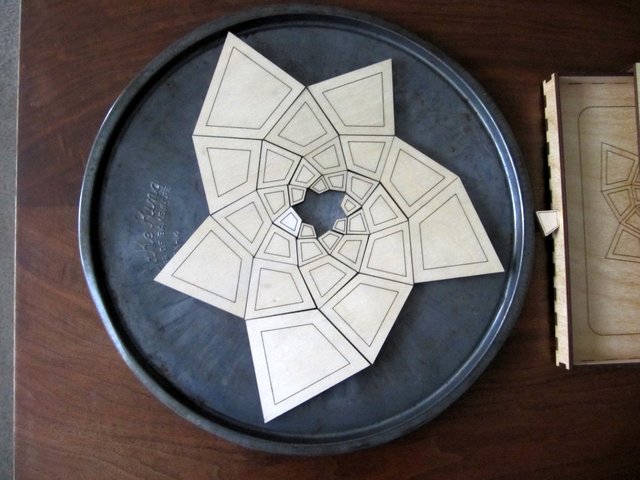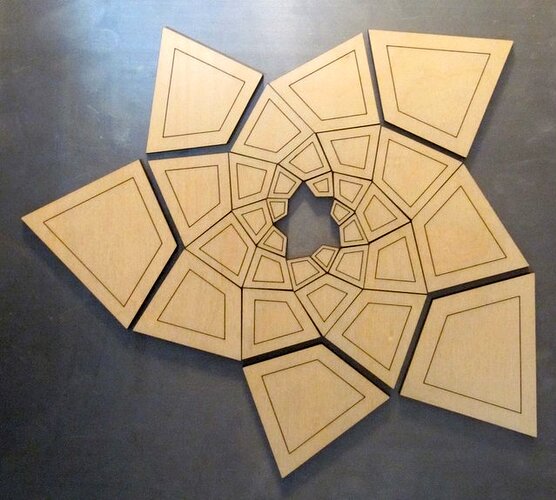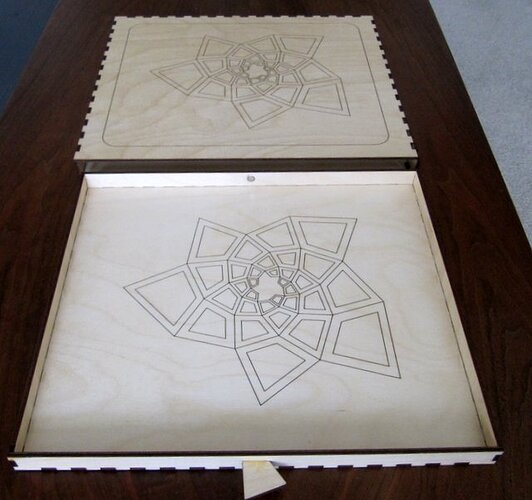The tile gives a vocabulary for reference searches.
Finding a growth pattern of plant leaves that is mathematically describable is astounding. Generating such a growth pattern and connecting adjacent points with straight lines produces spirals as picked out by eye; i.e. parastichies. All quadrangles are the same shape but different sizes. Furthermore the number of right-hand and left-hand parastichies are adjacent Fibonacci numbers.
The (8,13) Fibonacci pattern jigsaw puzzle shown by John Edmark https://www.instructables.com/id/Fibonacci-Spiral-Jigsaw-puzzle/ and then by smcgathyfay on Glowforge Everything Else site, Fibonacci Spiral Puzzle
gave inspiration to make a similar puzzle but with fewer tiles. Instead of the usual lock-key join between puzzle pieces, a magnet in each piece holds tiles against a magnetic sheet. To reduce the number of tiles for the completed puzzle, a (5,8) fourth-order phyllotaxis pattern was generated.
Tiles were made in two halves from 1/8 inch material. The bottom pieces have a hole cut for mounting a 6 X 2 mm magnet. Recess the magnets near the bottom of each bottom tile using the small rectangular 1.750-inch rectangular piece to assist. Mating sizes are glued together making tiles ~ ¼-inch high. Magnets were from Amazon: FINDMAG 120 pieces 6 X 2 mm.
An option would be to use one-thickness tiles with no magnets and a standard jigsaw join.
The first box-drawer prototype was made large enough to allow puzzle assembly inside the drawer. A soft iron plate, e.g. flashing from Lowe’s, and puzzle tiles can be stored inside the drawer.
Although the kerf parameter was set to 0.007 inches. only one of the many finger joints was squeaky tight. Three sheets of material were used for the box/drawer large parts. Other parts were cut from scrap. The drawer could have more clearance inside the box.
Assemble drawer first, gluing joints as needed and making sure there are no gaps in the finger joints. Assemble the box and insert the drawer with two strips of 110-LB card stock as spacers between the box side walls and the drawer sides. Then glue the box finger joints with cyanoacrylic from the outside. Remove the spacer strips.
Instead of an iron plate for assembly, a 12 inch steel pizza or cookie pan can be used. Smaller box size can be used without storage for the pan in the tile box. Walmart has non-stick steel 12 inch pans for $1.98

Solution
There are several solutions based on the tile generation algorithm. One of the best:
Sort the tiles by size starting with largest as number 1. Now start eight piles with tiles N=1 through 8. Then for the N=1 pile, select tile (1+8), then tile ((1+8)+8), then tile (17+8) to make a four-tile stack. Sequential tile numbers are selected by (n+8) . Then repeat this for pile N=2 through N=8 getting eight stacks of four tiles each.
These stacks are easy to assemble individually. The assembled eight spirals are moved sequentially to nesting positions completing the solution. Each of these parastichy spirals groups will be rotated 137.5 degrees between successive groups in the assembled solution.
Cheat: The perimeter frame is handy to arrange the largest perimeter tiles at correct angles and relative locations.

